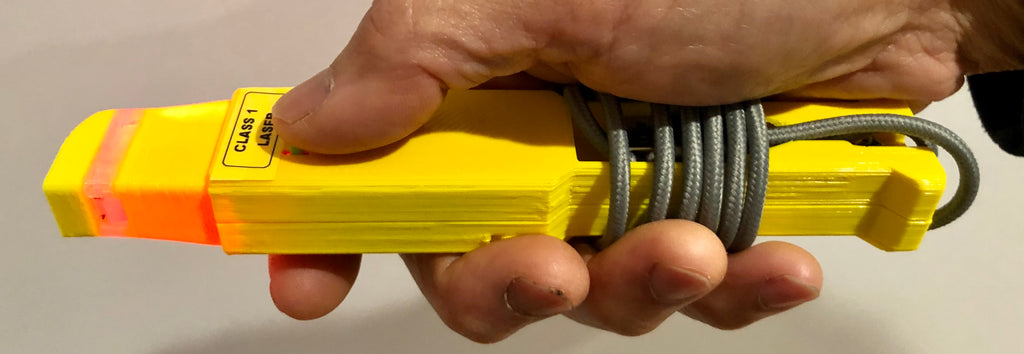Customer Feature: Karl Lew

Introducing TinyCircuits customer Karl Lew. Karl has designed and built what he is calling the SightSaber, a haptic electronic range finder inspired by the traditional support cane used by the visually impaired.
Karl is gradually losing his sight, he can no longer drive or read printed material, so thinking ahead he purchased a support cane for his own use. He discovered that the support cane is a wonderful, versatile instrument that provides significant freedom to the visually impaired. Support canes are those long, collapsible red and white canes used by the blind or visually impaired to locate obstacles in their path of travel. These canes are remarkable devices on their own and offer mobility to people who might otherwise suffer alone in their house, support canes represent freedom.
Support canes reach out and tap objects, allowing its user to perceive what is in their direct vicinity. A significant drawback to the traditional support cane is that sometimes that tapping violates another person. This means that blind people cannot freely use their support canes in crowded spaces with people whose backs are turned to the support cane. This can lead to awkwardness and embarrassment as people are tapped from behind and because of this he decided to work on a project that might help him in years to come.
Karl's solution to this problem, the SightSaber. It is a haptic electronic rangefinder that uses the TOF Class 1 laser to emulate a support cane. This device uses a lot of TinyCircuits parts including the following:
- TinyZero with Accelerometer
- TOF Distance Sensor
- LRA Driver Wireling
- RGB LED Wireling
- 500mAh LiPo battery
- Micro USB Cable
- Wireling 5 Pin extension cables
The support cane Karl has designed is basically an infrared lightsaber that buzzes and flashes when the beam touches something in range. The beam is produced by the TOF Distance Sensor Wireling to detect nearby objects, then the LRA Driver Wireling provides tactile feedback on the range of detected objects and the TinyZero with Accelerometer analyzes range data and then provides continuous haptic feedback for the user and visual feedback for the passersby. The SightSaber uses operating system Milli or (OMilli) which basically turns your Arduino MCU into a multi-threaded operating system to support all of the TinyCircuit's devices.
The most challenging part of this project was figuring out how to provide useful haptic feedback. The Wireling LRA Driver has a large library of haptic effects that can be used in combination to announce events like sleep, wake, calibration, contact near or contact far. The most critical part is to provide the information quickly so that the user can detect obstacles and avoid dangers. In the future, Karl hopes that this project might inspire makers to build their own SightSaber and donate them to people in need.
Karl said,
"I've long been a fan of TinyCircuits. When I learned about the TOF Distance Sensor Wireling, I was quite excited. HERE is a sensor that can be used to build a touch-less support cane. Indeed, with all the Wirelings, all of a sudden we've got ALL the parts needed to make such a support cane. "
Check out the SightSaber in action!
Karl is currently using Wirelings on a scaled-down version of his OyaPi project. OyaPi is Raspberry Pi 3 software for monitoring and controlling aeroponics systems. With OyaPi you can schedule grow tent lighting cycles as well as pump misting cycles. OyaPi automatically logs sensor data and provides you with live measurements as well as historical charts.
Karl is always interested in collaborating with others, you can reach him via email at karl@oyamist.com
Interested in having your tech featured in a blog post like this? Tag us in your projects on Facebook and Twitter, or post in our Forum under "User Projects." or email us at info@tinycircuits.com We'll be on the lookout for our next candidate!


